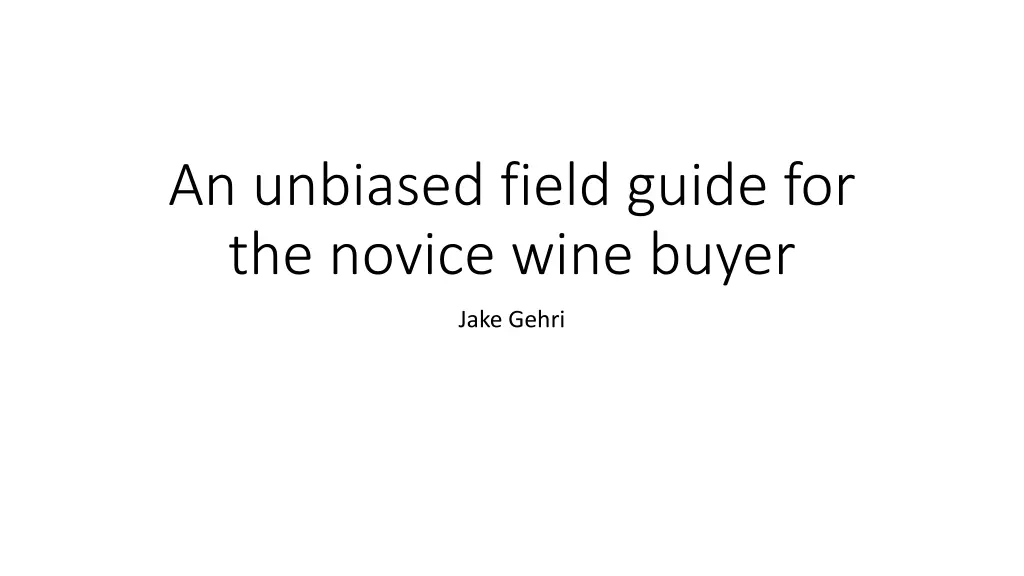
Field Guide for Novice Wine Buyers: Unbiased Analysis & Recommendations
Discover an unbiased field guide for novice wine buyers, offering quantitative evidence on selecting the best wines based on factors like variety, region, vintage, and price. Dive into data analysis and manipulation techniques to find the top wine choices, along with common questions to consider when shopping for wine.
Download Presentation

Please find below an Image/Link to download the presentation.
The content on the website is provided AS IS for your information and personal use only. It may not be sold, licensed, or shared on other websites without obtaining consent from the author. If you encounter any issues during the download, it is possible that the publisher has removed the file from their server.
You are allowed to download the files provided on this website for personal or commercial use, subject to the condition that they are used lawfully. All files are the property of their respective owners.
The content on the website is provided AS IS for your information and personal use only. It may not be sold, licensed, or shared on other websites without obtaining consent from the author.
E N D
Presentation Transcript
An unbiased field guide for the novice wine buyer Jake Gehri
Introduction The purpose of this paper: act as an unbiased field guide to the novice wine buyer, providing quantitative evidence for choosing, on average, the best possible wine based on a variety of factors: Variety State/Province Year Price
Literature Review Bordeaux Wine Vintage Quality and the Weather by Orley Ashenfelter, David Ashmore & Robert Lalonde looking at quality of wine by climate of growing location There has been no published analysis using this data
Data The data contain over 130,000 observations and was scraped from WineEnthusiast on November 22nd, 2017 The data consist of 13 columns, of which I used 7 for my analysis: Country Points rating assigned to the wine by the taster Price Province Taster Name Title used to parse year from the title Variety type of grape used (ex. Pinot Noir, Chardonnay)
Data Manipulation Varieties > 3000 Provinces > 200 Tasters >= 1000 Years with >= 100 Final n = 38,366 8 varieties, 25 provinces, 10 tasters, years 2016-1998 (not including 1999)
Data Manipulation (2) Unbiased point scale: I have manipulated each wine tasters point system, standardizing their mean points to eliminate taster bias. Scalar = mean(all tasters) / mean(taster_1) Unbiased points = scalar * old_points
Questions one may ask themselves when wine shopping Highest quality wine variety? How does vintage play a role in wine quality and pricing? Best wine producing province? How does price affect wine quality? How does age of wine affect price/quality? Best producer of each variety? Best year for each province? Best overall wine?
Descriptive Statistics Best year (globally): Best variety (globally) Syrah: 89.49, Pinot Noir: 89.39 Riesling: 89.14 Red Blend: 88.96 Cabernet Sauvignon: 88.76 Bordeaux-style Red Blend: 88.67 Chardonnay: 88.55 Sauvignon Blanc: 87.97 2005: 89.24 2014: 89.19 2013: 89.05 2012: 89.02 2004: 89.01 2009: 88.87 2015: 88.86 2010: 88.78 2006: 88.74 2008: 88.59 2007: 88.56 2011: 88.55 1998: 87.95 2016: 87.82 2000: 86.17 Best province: Rheingau, Germany: 91.14 Worst province: Central Valley, California: 86.88
Methodology / OLS Regression Points??????= ? + ?1????? + ?2???????? + ?3??????? + ?4???? ???????? + ?5???????? ??????? + ?6 ??????? + ?7 ???? ???????? ??????? ???? Province ref = California Variety ref = Pinot Noir Year ref = 2016
Results How does price affect wine quality? ????? = ? + ?1???????????? R-squared: 0.135 As expected, better wines are more expensive. The consumer will on average pay an additional $6.97 for every incremental point increase in wine quality
Results (2) How does vintage affect price/quality? ????? = ? + ?1????????????+ ?2???? ????????????= ? + ?1????? + ?2???? R-squared: 0.137 Wine, on average, gets more expensive over time. Holding points constant. Expected supply and demand. Newer wines are on average better than older wines. Holding price constant.
Results (3) Best province for each variety? Best year for x province? Points?????? = ? + ?1????? + ?2???????? + ?3??????? + ?4???????? ??????? Points?????? = ? + ?1????? + ?2???????? + ?3???? + ?4???? ??????? Bordeaux-style Red Blend from Colchagua Valley: 92.33 Cabernet Sauvignon from Sicily & Sardinia: 89.63 Chardonnay from Catalonia: 89.25 Pinot Noir from Rheingau: 89.50 Red Blend from Maipo Valley: 90.71 Riesling from Rheingau: 89.69 Sauvignon Blanc from Catalonia: 89.65 Syrah from Catalonia: 90.68 Adj. R-squared: 0.210
Results (4) What year, variety, location has the best overall wine? Points?????? = ? + ?1????? + ?2???????? + ?3??????? + ?4???? + ?5???? ???????? + ?6???????? ??????? + ?7???? ??????? + ?8 ???? ???????? ??????? Top 5 2006 Pinot Noir from Southwest France: 96.59 2009 Syrah from Northern Spain': 95.80 2004 Syrah from Casablanca Valley': 95.56 2004 Cabernet Sauvignon from Sicily & Sardinia: 95.11 2012 Cabernet Sauvignon from Catalonia': 95.10 Adj. R-squared: 0.243
Results (5) Is the informed novice better of than the blind novice? (A question from Ray Fair) Mean score = 88.91 Assuming the expected value of randomly pulling one wine bottle off the shelf is equal to our sample mean of 88.91, and the mean of our top 5 predicted wines is 95.632, the informed novice is > 2 standard deviations better off than the blind purchaser.
Weaknesses and Limitations My choice to limit the dataset to 8 varieties, 25 provinces, 10 tasters, years 2016-1998 (not including 1999) may exclude some low quantity producing provinces with exceptionally good wines I justify this by arguing that selecting the most abundant wine varieties, locations and years creates a realistic scenario that any purchaser may themselves face upon entering any extraordinarily average wine store. Additionally, by having a large number of variability within my chosen factors (etc. 25 provinces), my triple interaction best possible wine prediction may have too few wines falling under that category to be deemed significant
